- Clone
- RB6-8C5 (See other available formats)
- Regulatory Status
- RUO
- Other Names
- Gr-1
- Isotype
- Rat IgG2b, κ
- Ave. Rating
- Submit a Review
- Product Citations
- 1 publications
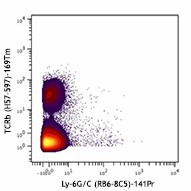
| Cat # | Size | Price | Quantity Check Availability | Save | ||
|---|---|---|---|---|---|---|
| 108449 | 100 µg | 94 CHF | ||||
Gr-1 is a 21-25 kD protein also known as Ly-6G/Ly-6C. This myeloid differentiation antigen is a glycosylphosphatidylinositol (GPI)-linked protein expressed on granulocytes and macrophages. In bone marrow, the expression levels of Gr-1 directly correlate with granulocyte differentiation and maturation; Gr-1 is also transiently expressed on bone marrow cells in the monocyte lineage. Immature Myeloid Gr-1+ cells play a role in the development of antitumor immunity.
Product DetailsProduct Details
- Verified Reactivity
- Mouse
- Antibody Type
- Monoclonal
- Host Species
- Rat
- Immunogen
- Raised against granulocytes of mouse origin
- Formulation
- Phosphate-buffered solution, pH 7.2, containing 0.09% sodium azide and EDTA.
- Preparation
- The antibody was purified by affinity chromatography.
- Concentration
- 1.0 mg/ml
- Storage & Handling
- The Ly-6G/Ly-6C antibody solution should be stored undiluted between 2°C and 8°C.
- Application
-
FC - Quality tested
CyTOF® - Verified - Recommended Usage
-
This product is suitable for use with the Maxpar® Metal Labeling Kits. For metal labeling using Maxpar® Ready antibodies, proceed directly to the step to Partially Reduce the Antibody by adding 100 µl of Maxpar® Ready antibody to 100 µl of 4 mM TCEP-R in a 50 kDa filter and continue with the protocol. Always refer to the latest version of Maxpar® User Guide when conjugating Maxpar® Ready antibodies.
- Application Notes
-
Clone RB6-8C5 binds with high affinity to mouse Ly-6G molecules and to a lower extent to Ly-6C19. Clone RB6-8C5 impairs the binding of anti-mouse Ly-6G clone 1A819. However, clone RB6-8C5 is able to stain in the presence of anti-mouse Ly-6C clone HK1.420.
The RB6-8C5 antibody has been used to identify peripheral blood neutrophils and deplete granulocytes in vivo. Additional reported applications (for relevant formats of this clone) include: in vitro complement-mediated cytotoxicity2, in vivo depletion3-5,9, immunoprecipitation1, immunohistochemical staining6 (including paraffin-embedded sections9,16,33-35, acetone-fixed frozen sections11 and zinc-fixed sections15), and Western blotting7. RB6-8C5 is not suitable for depletion of hepatic myeloid derived suppressor cells (MDSCs)20.
Special Note: For in vivo studies or highly sensitive assays, we recommend Ultra-LEAF™ purified antibody (Cat. No. 108436). - Additional Product Notes
-
Maxpar® is a registered trademark of Standard BioTools Inc.
-
Application References
(PubMed link indicates BioLegend citation) -
- Fleming TJ, et al. 1993. J. Immunol. 151:2399. (IP)
- Brummer E, et al. 1984. J. Leukocyte Biol. 36:505. (CMCD)
- Stoppacciaro A, et al. 1993. J. Exp. Med. 178:151. (Deplete)
- Tumpey TM, et al. 1996. J. Virol. 70:898. (Deplete)
- Czuprynski CJ, et al. 1994. J. Immunol. 152:1836. (Deplete)
- Nitta H, et al. 1997. Cell Vision 4:73. (IHC)
- Jutila MA, et al. 1988. Eur. J. Immunol. 18:1819. (WB)
- Engwerda CR, et al. 2004. Am. J. Pathol. 165:2123.
- Brown CR, et al. 2004. Infect. Immun. 72:4956. (Deplete, IHC)
- Andoniou CE, et al. 2005. Nature Immunology 6:1011. (FC) PubMed
- Li M, et al. 2006. P. Natl. Acad. Sci USA 103:11736. (IHC)
- Dzhagalov I, et al. 2007. Blood 109:1620. (FC) PubMed
- Fazilleau N, et al. 2007. Nature Immunol. 8:753. (FC) PubMed
- Heuser M, et al. 2007. Blood 110:1639. (FC) PubMed
- Wang T, et al. 2007. Infect. Immun. 75:1144. (IHC)
- Bosio CM, et al. 2007. J. Immunol. 178:4538. (IHC)
- Boehme SA, et al. 2009. Int. Immunol. 21:81. (IHC)
- Piao Y, et al. 2012. Neuro Oncol. 14:1379. PubMed
- Ribechini E, et al. 2009. Eur. J. Immunol. 39:3538.
- Ma C, et al. 2012. J. Leukoc. Biol. 92:1199.
- Li J, et al. 2012. Arthritis Rheum. 64:1098. PubMed
- Fan Q, et al. 2014. Cancer Res. 74:471. PubMed
- Korrer MJ, et al. 2014. PLoS One. 9:91370. PubMed
- Morshed M, et al. 2014. J Immunol. 192:5314. PubMed
- Collins C, et al. 2014. PNAS. 111:9899. PubMed
- Madireddi S, et al. 2014. J Exp Med. 211:1433. PubMed
- Bianchi G, et al. 2014. Cell Death Dis. 5:1135. PubMed
- Guo H, et al. 2014. J Leukoc Biol. 96:419. PubMed
- Roderick JE, et al. 2014. PNAS. 111:14436. PubMed
- Distel E, et al. 2014. Circ Res. 115:759. PubMed
- Iwai H, et al. 2015. Tuberculosis. 95:246. PubMed
- Charmsaz S, et al. 2015. PLoS One. 10:130692. PubMed
- Whiteland J, et al. 1994 J Histochem Cytochem 43:3 (IHC-P)
- Brown C, et al. 2003 J Immunology 171:2 (IHC-P)
- Obregon-Henao A, et al. PLoS One 8:11 (IHC-P)
- Product Citations
-
- RRID
-
AB_2563785 (BioLegend Cat. No. 108449)
Antigen Details
- Structure
- 21-25 kD
- Distribution
-
Granulocytes, monocytes
- Cell Type
- Granulocytes, Monocytes, Neutrophils
- Biology Area
- Immunology, Innate Immunity
- Antigen References
-
1. Fleming TJ, et al. 1993. J. Immunol. 151:2399.
2. Jutila MA, et al. 1988. Eur. J. Immunol. 18:1819.
3. Goni O, et al. 2002. Int. Immunol. 14:1125. - Gene ID
- 17067 View all products for this Gene ID 546644 View all products for this Gene ID
- UniProt
- View information about Ly-6G Ly-6C on UniProt.org
Related FAQs
- Can I obtain CyTOF data related to your Maxpar® Ready antibody clones?
-
We do not test our antibodies by mass cytometry or on a CyTOF machine in-house. The data displayed on our website is provided by Fluidigm®. Please contact Fluidigm® directly for additional data and further details.
- Can I use Maxpar® Ready format clones for flow cytometry staining?
-
We have not tested the Maxpar® Ready antibodies formulated in solution containing EDTA for flow cytometry staining. While it is likely that this will work in majority of the situations, it is best to use the non-EDTA formulated version of the same clone for flow cytometry testing. The presence of EDTA in some situations might negatively affect staining.
- I am having difficulty observing a signal after conjugating a metal tag to your Maxpar® antibody. Please help troubleshoot.
-
We only supply the antibody and not test that in house. Please contact Fluidigm® directly for troubleshooting advice: http://techsupport.fluidigm.com/
- Is there a difference between buffer formulations related to Maxpar® Ready and purified format antibodies?
-
The Maxpar® Ready format antibody clones are formulated in Phosphate-buffered solution, pH 7.2, containing 0.09% sodium azide and EDTA. The regular purified format clones are formulated in solution that does not contain any EDTA. Both formulations are however without any extra carrier proteins.
Other Formats
View All Ly-6G/Ly-6C Reagents Request Custom ConjugationCompare Data Across All Formats
This data display is provided for general comparisons between formats.
Your actual data may vary due to variations in samples, target cells, instruments and their settings, staining conditions, and other factors.
If you need assistance with selecting the best format contact our expert technical support team.
-
APC anti-mouse Ly-6G/Ly-6C (Gr-1)
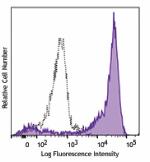
C57BL/6 mouse bone marrow stained with Ly-6G/Ly-6C APC (clon... -
Biotin anti-mouse Ly-6G/Ly-6C (Gr-1)
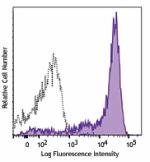
C57BL/6 mouse bone marrow stained with biotinylated Ly-6G/Ly... -
FITC anti-mouse Ly-6G/Ly-6C (Gr-1)

C57BL/6 mouse bone marrow stained with Ly-6G/Ly-6C (clone RB... -
PE anti-mouse Ly-6G/Ly-6C (Gr-1)
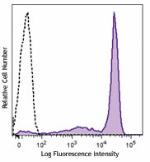
C57BL/6 mouse bone marrow cells were stained with Ly-6G/Ly-6... -
PE/Cyanine5 anti-mouse Ly-6G/Ly-6C (Gr-1)
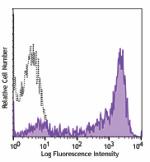
C57BL/6 mouse bone marrow stained with Ly-6G/Ly-6C (clone RB... -
Purified anti-mouse Ly-6G/Ly-6C (Gr-1)
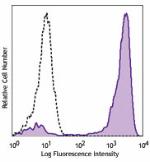
C57BL/6 mouse bone marrow cells were stained with purified L... -
PE/Cyanine7 anti-mouse Ly-6G/Ly-6C (Gr-1)
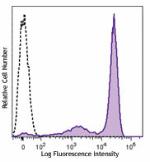
C57BL/6 mouse bone marrow cells were stained with Ly-6G/Ly-6... -
Alexa Fluor® 488 anti-mouse Ly-6G/Ly-6C (Gr-1)
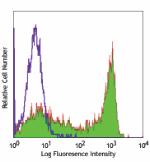
C57BL/6 mouse bone marrow (gated on myeloid cell population)... -
Alexa Fluor® 647 anti-mouse Ly-6G/Ly-6C (Gr-1)
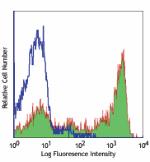
C57BL/6 mouse bone marrow (gated on myeloid cell population)... -
Alexa Fluor® 700 anti-mouse Ly-6G/Ly-6C (Gr-1)

C57BL/6 mouse bone marrow (gated on myeloid cell population)... -
Brilliant Violet 711™ anti-mouse Ly-6G/Ly-6C (Gr-1)
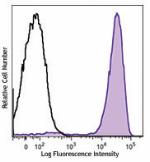
C57BL/6 mouse bone marrow cells were stained with Ly-6G/Ly-6... -
APC/Cyanine7 anti-mouse Ly-6G/Ly-6C (Gr-1)

C57BL/6 mouse bone marrow stained with CD11b FITC and Ly-6G/... -
Pacific Blue™ anti-mouse Ly-6G/Ly-6C (Gr-1)
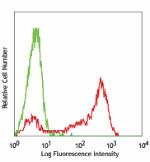
C57BL/6 mouse bone marrow (gated on myeloid cell population)... -
PerCP/Cyanine5.5 anti-mouse Ly-6G/Ly-6C (Gr-1)

C57BL/6 mouse bone marrow were stained with CD11b FITC and L... -
PerCP anti-mouse Ly-6G/Ly-6C (Gr-1)
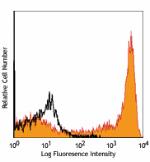
C57BL/6 mouse bone marrow (gated on myeloid cell population)... -
Brilliant Violet 421™ anti-mouse Ly-6G/Ly-6C (Gr-1)
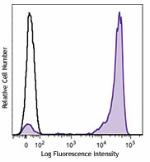
C57BL/6 mouse bone marrow cells were stained with Ly-6G/Ly-6... -
Brilliant Violet 570™ anti-mouse Ly-6G/Ly-6C (Gr-1)

C57BL/6 mouse bone marrow cells were stained with Ly-6G/Ly6C... -
Ultra-LEAF™ Purified anti-mouse Ly-6G/Ly-6C (Gr-1)
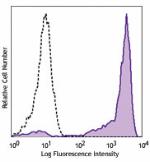
C57BL/6 mouse bone marrow cells were stained with LEAF™ puri... -
Brilliant Violet 510™ anti-mouse Ly-6G/Ly-6C (Gr-1)
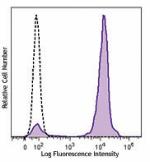
C57BL/6 mouse bone marrow cells were stained with Ly-6G/Ly-6... -
Brilliant Violet 605™ anti-mouse Ly-6G/Ly-6C (Gr-1)
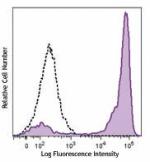
C57BL/6 mouse bone marrow cells were stained with Ly-6G/Ly-6... -
Brilliant Violet 650™ anti-mouse Ly-6G/Ly-6C (Gr-1)
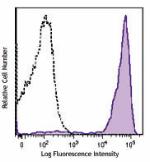
C57BL/6 mouse bone marrow cells were stained with Ly-6G/Ly-6... -
Alexa Fluor® 594 anti-mouse Ly-6G/Ly-6C (Gr-1)
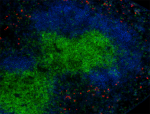
C57BL/6 mouse frozen lymph node section was fixed with 4% pa... 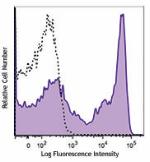
C57BL/6 mouse bone marrow cells were stained with Ly-6G/Ly-6... -
Purified anti-mouse Ly-6G/Ly-6C (Gr-1) (Maxpar® Ready)
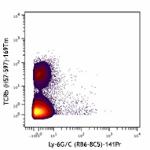
Mouse splenocytes stained with 141Pr anti-Ly-6G/C (RB6-8C5) ... -
PE/Dazzle™ 594 anti-mouse Ly-6G/Ly-6C (Gr-1)

C57BL/6 mouse bone marrow cells were stained with Ly-6G/Ly-6... -
APC/Fire™ 750 anti-mouse Ly-6G/Ly-6C (Gr-1)
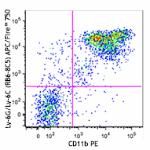
C57BL/6 mouse bone marrow cells were stained with CD11b PE a... 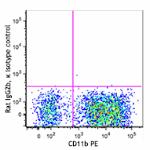
-
TotalSeq™-A0116 anti-mouse Ly-6G/Ly-6C (Gr-1)
-
TotalSeq™-C0116 anti-mouse Ly-6G/Ly-6C (Gr-1)
-
TotalSeq™-B0116 anti-mouse Ly-6G/Ly-6C (Gr-1)
-
Spark Blue™ 550 anti-mouse Ly-6G/Ly-6C (Gr-1)

C57BL/6 mouse bone marrow was stained with CD11b APC and Ly-... -
APC/Fire™ 810 anti-mouse Ly-6G/Ly-6C (Gr-1)
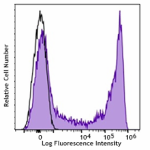
C57BL/6 mouse bone marrow cells were stained with Ly-6G/Ly-6... -
Spark Violet™ 423 anti-mouse Ly-6G/Ly-6C (GR-1) Antibody

C57BL/6 mouse bone marrow cells were stained with anti-mouse... -
Spark UV™ 387 anti-mouse Ly-6G/Ly-6C (GR-1)

C57BL/6 mouse bone marrow cells were stained with anti-mouse... -
Spark Violet™ 538 anti-mouse Ly-6G/Ly-6C (Gr-1)

C57BL/6 mouse bone marrow were stained with anti-mouse CD11b... -
Spark PLUS UV395™ anti-mouse Ly-6G/Ly-6C (Gr-1)

C57BL/6 mouse bone marrow cells were stained with anti-mouse... -
Spark Red™ 718 anti-mouse Ly-6G/Ly-6C (Gr-1) (Flexi-Fluor™)
-
Spark Blue™ 574 anti-mouse Ly-6G/Ly-6C (Gr-1) (Flexi-Fluor™)


 Login / Register
Login / Register 













Follow Us